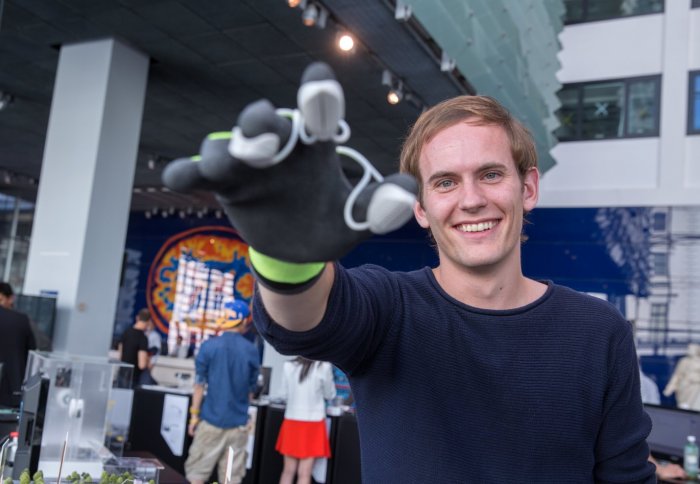
Morten Gronning Nielsen - 'Happaratus'

From a sonar inspired headset to a smart exercise suit, the Imperial Show celebrates the best that student design has to offer the technology world.
The show, which runs until Thursday 9 July 2015 in the College Main Entrance, features nearly 50 different devices developed by students on the Innovation Design Engineering (IDE) and Global Innovation Design (GID) courses - run jointly by Imperial’s Dyson School of Design Engineering and the Royal College of Art.

Sonna - one of the projects on display
“With this year’s founding of the Dyson School of Design Engineering at Imperial, the future of design, engineering and their application looks brighter than ever.
“This impressive show is a testament to our students’ talent, drive, and ingenuity. We look forward to watching their careers develop.”
With products ranging from medical tech to the latest in digital sport equipment the innovations covered a range of exciting fields.
Projects on display this week include:
Happaratus
Morten Grønning Nielsen’s Happaratus is a glove that can be used to sculpt hard materials like stone and wood by hand. Grønning Nielsen, who studied on the IDE course, created the ‘power glove’ to extend the capabilities of the hand as a sculpting tool.
Happaratus uses abrasive pads mounted onto the tips of the glove’s thumb, index and middle fingers. The pads, powered by an electric motor, oscillate in opposite directions allowing the user to carve away at an object’s surface with their fingers.
Morten said: “Many designers and makers will tell you that the hand is the perfect tool for shaping and sculpting and now Happaratus gives the user the power to do it.
“The pads are flexible and you can make them in different shapes and sizes depending on the needs of the user. Happaratus can be adapted for everything from carving stone to restoring furniture.”
Bio Knit
Ammo Liaos has developed Bio Knit, a single material that can simultaneously display soft, flexible and hard textures using biomimicry.
Liao’s highly adaptable material utilises 3d knitting and heat-press technology to create a material that can adopt a range of forms, allowing it to be used in a variety of different ways. Whilst being one single matieral Bio Knit can be used in products which have both soft and hard components such as helmets, luggage or shoes.
By using the simple multi-function material designers can both simplify the making process of an item and improve recycling by eliminating the need for separating methods - reducing the cost and energy use of the recycling process.
Ammo said: “I chose to use the material to develop a shoe as it’s a great example of Bio Knit’s benefits. Around 330 million shoes are sold in the UK each year, each difficult to recycle due to the large amount of materials used in them. By using one multi-function material it saves both in production processes and makes recycling easier.”
Moya Power
Charlotte Slingsby has created Moya Power, a semi-transparent low cost material that could be used to harvest small amounts of wind energy in a range of locations.

Inspired by Slingsby’s native South Africa, where power-cuts are a frequent occurrence, Moya Power meets the challenge of developing a new way of harnessing energy that does not require expensive land or infrastructure to set up.
Moya Power uses a number of finger-like filaments which are moved by passing currents of air - with the movement harnessed to generate electricity. The filaments can be optimised based on wind energy analysis for maximum efficiency, or adapted to architect’s designs to be used as a dynamic building façade.
The end result is a low cost flexible material that can wrap around buildings, coat windows, line bridges or be hidden in structures unlocking their potential as energy generation site.
Charlotte said: “Moya is a low cost sheeting material used to generate power from abundant low grade wind energy that would otherwise go unused.
“The flexible and semi-transparent form of the material mean you could use it from everything from lining tube tunnels to coating entire buildings.”
Other highlights include ‘Ally Form’, a novel self-application bandage which enables anyone to give first aid support to themselves or others in case of heavy bleeding without prior training, and ‘Skytree’, an online green roof design platform drawing together data on surrounding spaces to create functional habitats that span city rooftops.
Article text (excluding photos or graphics) available under an Attribution-NonCommercial-ShareAlike Creative Commons license.
Photos and graphics subject to third party copyright used with permission or © Imperial College London.
Reporters
![Thomas Angus [Photographer]](http://www.imperial.ac.uk/ImageCropToolT4/imageTool/uploaded-images/1400-crete-blog-048_1639140671384_x1.jpg)
Thomas Angus [Photographer]
Communications Division

Contact details
Tel: +44 (0)20 7594 2858
Email: t.angus@imperial.ac.uk
Show all stories by this author
Jon Narcross
Communications and Public Affairs

Contact details
Email: press.office@imperial.ac.uk
Show all stories by this author




Leave a comment
Your comment may be published, displaying your name as you provide it, unless you request otherwise. Your contact details will never be published.